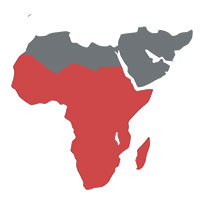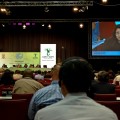Behind closed doors: Day 4 at COP17
Tim Hall | December 2, 2011.
Intense secret negotiations and a quickened tempo characterised day four at COP17. With the previous days spent drawing lines in the sand, national delegations got to work making genuine progress on compromise options.
It is expected that by Saturday night a number of negotiating text proposals will be released, as ministers start arriving for the second week of negotiations.
Reports emerged of long standing tensions between China and vulnerable nations within the G77 starting to heat up, with China and fellow BASIC nations of Brazil, South Africa and India pushing for no new treaty that would bind their emerging economies—not until 2020 at least.
Bloomberg reported that the European Union (EU) hopes to get China to agree on a roadmap to a treaty through the EU’s support of 2020 as the starting year.
For vulnerable nations already feeling the impacts of climate change, this is unacceptable.
Speaking on behalf of the Alliance of Small Island Nations, Grenada made clear the urgency of Durban. “Everything needs a plan, but a roadmap with a date that takes us away from the urgency of decision making in Durban, no.”
The urgency was made clear to world leaders with new research suggesting methane-intensive permafrost has begun thawing at a rapid pace, emitting gases three-times more effective at trapping heat than CO2. Thawing permafrost has long been cited as a potential tipping point, triggering a positive feedback loop as a warmer climate releases gases which create further warming effects.
The urgency and cracks within the G77 and China was also brought to the fore as the least developed nations (LDCs)—a group of forty-eight largely African nations—tabled a motion pushing for a new deal within a year. The deal should also aim for a maximum 1.5°C warming, as opposed to the 2°C warming stipulated in the Copenhagen Accord. It further pushes for a peak of emissions by 2015 and an 85 per cent reduction on 1990 levels by 2050. It is a tough ask, considering most developed nations are banking on no new talks about a global treaty to begin until 2015, and puts the LDCs in direct conflict to BASIC nations.
As Richard Black from the BBC points out, developing nations have previously been uneasy about emission reduction goals for 2050, as it implies they will have to accept binding cuts to their emissions. The LDC submission and AOSIS statements may become significant moments in splitting the global South at climate negotiations.
Finally, an evaluation of the Clean Development Mechanism will be undertaken next year. The CDM under Kyoto allows companies and nations to earn credits to offset emissions, in exchange for financing renewable energy projects in the developing world. Last year the CDM was valued at $1.5 billion, with 3,600 projects having been sponsored. Brazil and China noted that without a global agreement on emission reductions, demand for CDM credits would shrink. CD would have no future without Kyoto, the two emerging economies are reported as saying.
It is another bargaining chip which will come in handy over the weekend and next week. The feeling that the tempo has gone up a notch has already arrived, and the next few days will no doubt feature a few late nights as compromise options are nutted out behind closed doors.













comment